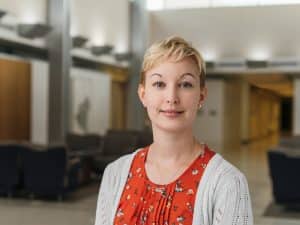SAN ANTONIO (September 28, 2022) – Four Texas Biomed Staff Scientists have received funding from the National Institutes of Health (NIH) to take on exploratory research projects with potential for significant impact. Each R21 grant provides about $400,000 for researchers to test hypotheses and gather more data over two years.
“These are very important grants that help advance the careers of our up-and-coming investigators,” says Joanne Turner, Texas Biomed’s Executive Vice President for Research. “Often, work completed with these grants provides the initial results necessary to then successfully compete for larger, five-year grants. Having four of our staff scientists receive R21s this year is an excellent indicator of Texas Biomed’s commitment to and success with training the next generation.”
These grants also display the wide range of research taking place at Texas Biomed and how basic science is critical for tackling some of the world’s greatest health challenges.
Single-cell connections
 Staff Scientist Riti Sharan, PhD, is investigating how HIV reactivates latent tuberculosis (TB) infection, worsening the outcome for patients battling two diseases. People with HIV are 18 times more likely to develop TB infection than those without HIV, and TB is the leading cause of death for people living with HIV. In 2020, an estimated 214,000 people with HIV died of TB.
Staff Scientist Riti Sharan, PhD, is investigating how HIV reactivates latent tuberculosis (TB) infection, worsening the outcome for patients battling two diseases. People with HIV are 18 times more likely to develop TB infection than those without HIV, and TB is the leading cause of death for people living with HIV. In 2020, an estimated 214,000 people with HIV died of TB.
Dr. Sharan is seeking to identify the exact process that leads to TB reactivation in individuals with HIV, which could then suggest new treatment targets. Specifically, her R21 will enable her to conduct single-cell sequencing, which will provide a detailed map of what different cell types are doing at key points during the reactivation process.
“Single-cell sequencing is extremely expensive, but provides so much data,” Dr. Sharan says. “I think this is going to answer a lot of questions.”
Dr. Sharan will use cells collected from nonhuman primates during previous studies. The samples have been preserved, capturing a moment in time before, during and after infection and treatment with antiretroviral drugs. The single-cell RNA sequencing will be completed at Texas Biomed, which will generate a wealth of data about what genes are active, or turned on, versus turned off, in each individual cell. This reveals what cells are doing in a great level of detail.
“I am excited to dive deeper into my findings and hopefully identify the specific pathways and mechanism that lead to HIV reactivating TB and how antiretroviral therapy affects that,” she says.
Mollusks & microbiomes

Staff Scientists Winka Le Clec’h, PhD, and Frédéric Chevalier, PhD, are co-principal investigators on an R21 to study the microbiomes of snails, in search of new insight to combat parasites that infect more than 200 million people worldwide and is estimated to kill more than 200,000 every year. The parasitic worms, called schistosomes, must spend part of their lives in certain freshwater snails before infecting humans. Understanding how the snail microbiome influences the snail and the parasite could reveal new ways to block parasitic infection before it starts.
The researchers will compare microbiomes of different snail populations in their lab, and how these microbiomes could affect snail growth, survival and reproductive rates, as well as the schistosome infection.

“Perhaps we will identify a particular microbiome that makes snails more resistant to the schistosomes, and this could provide a nice strategy to control the parasites in the field that is more ecologically friendly than chemicals,” Dr. Chevalier says.
A key part of the project will be to try to generate snails without microbiomes, formally called germ-free snails, by raising them in a sterile environment, and see how they compare to snails with microbiomes. Other researchers tried this in the late 1950s – long before studying microbiomes were all the rage. Now, with much more sophisticated genetic sequencing techniques available, the Texas Biomed team will be able to gather more detailed data and insights.
“Germ-free snails could provide a powerful model to decipher the particular interactions between the host and specific bacteria, so we are excited to follow up on this old experiment, apply the latest technologies, and see what new answers we can uncover,” Dr. Le Clec’h says.
A more realistic model
Even though HIV is a descendant of an ancient virus found in monkeys, HIV itself does not replicate in monkeys. That means researchers studying HIV in animal models must rely on the monkey version of the virus, called simian immunodeficiency virus (SIV), and modified versions that combine some HIV genes into SIV. However, this makes it difficult to determine how well cures, treatments and vaccines might work, especially if they are designed to target specific genetic sequences of HIV, before testing them in human clinical trials. Staff Scientist Rajesh Thippeshappa, PhD, is seeking to solve this problem.

“It is very straightforward, but very challenging,” Dr. Thippeshappa says.
Instead of inserting HIV genes into SIV, he’s doing the opposite: adding just one gene from SIV to HIV, in order to help it replicate in pigtail macaques. While it works, virus replication levels are still too low to mimic human disease. His R21 will enable him to try to overcome this obstacle and achieve higher replication rates.
To do this, he will rely on the natural evolution of viruses, which mutate and adapt over time and as they encounter new hosts. By passing the virus through three pairs of monkeys – as few animals as possible – he anticipates replication will increase enough to finally have a more realistic model, or example system, of the human disease.
“It won’t be perfect,” Dr. Thippeshappa says. “The goal is to develop a reasonably good model that can help us test therapies, vaccines and cures.”
The model will also help researchers study what makes viruses jump from one species to another, and what mutations are required to begin replicating in a new host at levels that cause disease. As humans increasingly expand into wildlife habitat, the likelihood of encountering novel viruses also increases, which means understanding virus adaptation dynamics and having reliable research models will be even more critical.
The NIH’s National Institute for Allergy and Infectious Diseases funded the grants for Dr. Sharan – 1R21AI170148-01; Dr. Chevalier & Dr. Le Clec’h – 1R21AI171601-01; and Dr. Thippeshappa – 1R21AI165289-01A1.
